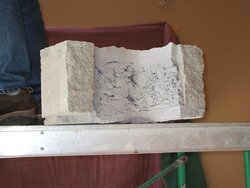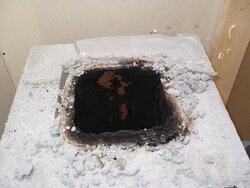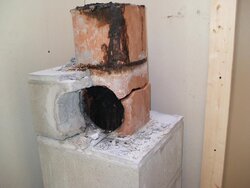recently, in the past 3 months, built a chimney in my new home. it is full 8x8 blocks with a clay liner from the basement up till it goes through the roof where it changes to brick. the basement thimble is blocked off right now but eventually will be used by my indoor boiler. the second floor thimble is currently being used with a circulator type stove similiar to the one's sold at aubuchon's. the problem that i am having is the blocks are developing hair line cracks vertically. they are not all in line with each other but in the same spot on every block that is cracked, about 4 inches from the right hand side. it seems that the only blocks that are cracking are the ones that are getting heat from the upstairs stove. i dont see any cracked below that thimble but suspect they will crack once i start using my boiler in the basement. my only thought is that the liner is expanding faster than the block and it causes it to crack. has anyone seen this? i cant seen any visible cracks in any liner but difficult to see where there is some creosote now in the chimney. this chimney will eventually be faced in stone but dont want to progress to that level if it needs to be taken down and redone.... please offer any explanations, theories or suggestions that you may have.
also wanted to add that the indoor temp of the building is not freezing so by some odd chance it was taking water in i dont think it would be caused by it freezing and cracking. i do have a concrete cap and dont see where any water could enter between the flue and the block.... my stove stack temps run a max of 400-500 f., typically 3-400.
also wanted to add that the indoor temp of the building is not freezing so by some odd chance it was taking water in i dont think it would be caused by it freezing and cracking. i do have a concrete cap and dont see where any water could enter between the flue and the block.... my stove stack temps run a max of 400-500 f., typically 3-400.


 i am not a mason personally(just made an attempt at it, lol) but my grandfather built A LOT of chimneys back when he worked as a mason and he has a hard time to believe this is happening to my chimney. processes and practices have obviously improved over the years however the old school ways still function safely and effectively. i have looked at several chimneys and asked several people about this, some say its normal and know why, they others know why and question whether it will be a problem down the road. their seems to be no visual cracks in the liner, however without a way to wash it and look with a camera its pretty difficult to see. the stove never gets run when i am not home, and i keep my chimneys very clean. at this point i think the best option is to cautiously use it, monitor and make a decision in the spring of tearing it down, repairing or rebuilding. any other thoughts are encouraged, its great to hear the differant opinions and thoughts on what is going on here. i will try to post some pics tomorrow. it seems that will relatively low flue temps (3-400 deg f.) the cracks never grow.
i am not a mason personally(just made an attempt at it, lol) but my grandfather built A LOT of chimneys back when he worked as a mason and he has a hard time to believe this is happening to my chimney. processes and practices have obviously improved over the years however the old school ways still function safely and effectively. i have looked at several chimneys and asked several people about this, some say its normal and know why, they others know why and question whether it will be a problem down the road. their seems to be no visual cracks in the liner, however without a way to wash it and look with a camera its pretty difficult to see. the stove never gets run when i am not home, and i keep my chimneys very clean. at this point i think the best option is to cautiously use it, monitor and make a decision in the spring of tearing it down, repairing or rebuilding. any other thoughts are encouraged, its great to hear the differant opinions and thoughts on what is going on here. i will try to post some pics tomorrow. it seems that will relatively low flue temps (3-400 deg f.) the cracks never grow.

